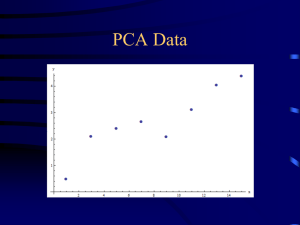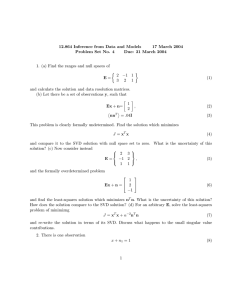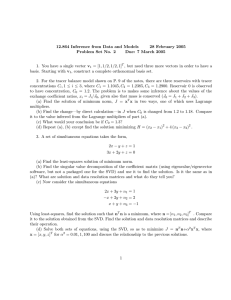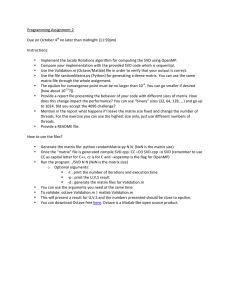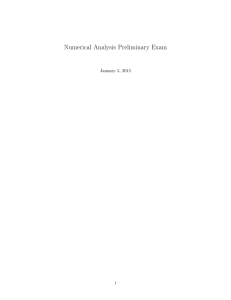Dimensionality reduction PCA, SVD, MDS, ICA, and friends Jure Leskovec
advertisement
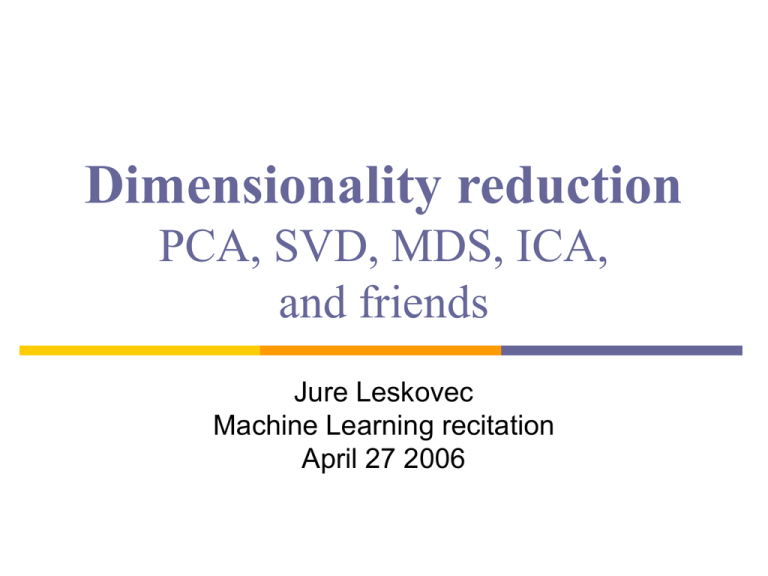
Dimensionality reduction PCA, SVD, MDS, ICA, and friends Jure Leskovec Machine Learning recitation April 27 2006 Why dimensionality reduction? Some features may be irrelevant We want to visualize high dimensional data “Intrinsic” dimensionality may be smaller than the number of features Supervised feature selection Scoring features: Mutual information between attribute and class χ2: independence between attribute and class Classification accuracy Domain specific criteria: E.g. Text: remove stop-words (and, a, the, …) Stemming (going go, Tom’s Tom, …) Document frequency Choosing sets of features Score each feature Forward/Backward elimination Choose the feature with the highest/lowest score Re-score other features Repeat If you have lots of features (like in text) Just select top K scored features Feature selection on text SVM kNN Rochio NB Unsupervised feature selection Differs from feature selection in two ways: Instead of choosing subset of features, Create new features (dimensions) defined as functions over all features Don’t consider class labels, just the data points Unsupervised feature selection Idea: Given data points in d-dimensional space, Project into lower dimensional space while preserving as much information as possible E.g., find best planar approximation to 3D data E.g., find best planar approximation to 104D data In particular, choose projection that minimizes the squared error in reconstructing original data PCA Algorithm PCA algorithm: 1. X Create N x d data matrix, with one row vector xn per data point 2. X subtract mean x from each row vector xn in X 3. Σ covariance matrix of X Find eigenvectors and eigenvalues of Σ PC’s the M eigenvectors with largest eigenvalues PCA Algorithm in Matlab % generate data Data = mvnrnd([5, 5],[1 1.5; 1.5 3], 100); figure(1); plot(Data(:,1), Data(:,2), '+'); %center the data for i = 1:size(Data,1) Data(i, :) = Data(i, :) - mean(Data); end DataCov = cov(Data); %covariance matrix [PC, variances, explained] = pcacov(DataCov); %eigen % plot principal components figure(2); clf; hold on; plot(Data(:,1), Data(:,2), '+b'); plot(PC(1,1)*[-5 5], PC(2,1)*[-5 5], '-r’) plot(PC(1,2)*[-5 5], PC(2,2)*[-5 5], '-b’); hold off % project down to 1 dimension PcaPos = Data * PC(:, 1); 2d Data 10 8 6 4 2 0 -2 2.5 3 3.5 4 4.5 5 5.5 6 6.5 7 7.5 Principal Components 1st principal vector 5 4 Gives best axis to project Minimum RMS error Principal vectors are orthogonal 3 2 1 0 -1 -2 2nd principal vector -3 -4 -5 -5 -4 -3 -2 -1 0 1 2 3 4 5 How many components? Check the distribution of eigen-values Take enough many eigen-vectors to cover 80-90% of the variance Sensor networks Sensors in Intel Berkeley Lab Link quality Pairwise link quality vs. distance Distance between a pair of sensors PCA in action Given a 54x54 matrix of pairwise link qualities Do PCA Project down to 2 principal dimensions PCA discovered the map of the lab Problems and limitations What if very large dimensional data? e.g., Images (d ≥ 104) Problem: Covariance matrix Σ is size (d2) d=104 |Σ| = 108 Singular Value Decomposition (SVD)! efficient algorithms available (Matlab) some implementations find just top N eigenvectors Singular Value Decomposition Problem: #1: Find concepts in text #2: Reduce dimensionality SVD - Definition A[n x m] = U[n x r] L [ r x r] (V[m x r])T A: n x m matrix (e.g., n documents, m terms) U: n x r matrix (n documents, r concepts) L: r x r diagonal matrix (strength of each ‘concept’) (r: rank of the matrix) V: m x r matrix (m terms, r concepts) SVD - Properties THEOREM [Press+92]: always possible to decompose matrix A into A = U L VT , where U, L, V: unique (*) U, V: column orthonormal (ie., columns are unit vectors, orthogonal to each other) UTU = I; VTV = I (I: identity matrix) L: singular value are positive, and sorted in decreasing order SVD - Properties ‘spectral decomposition’ of the matrix: 1 2 1 5 0 0 0 1 2 1 5 0 0 0 1 2 1 5 0 0 0 0 0 0 0 2 3 1 0 0 0 0 2 3 1 = u1 u2 x l1 l2 x v1 v2 SVD - Interpretation ‘documents’, ‘terms’ and ‘concepts’: U: document-to-concept similarity matrix V: term-to-concept similarity matrix L: its diagonal elements: ‘strength’ of each concept Projection: best axis to project on: (‘best’ = min sum of squares of projection errors) SVD - Example A = U L VT - example: retrieval inf. lung brain data CS MD 1 2 1 5 0 0 0 1 2 1 5 0 0 0 1 2 1 5 0 0 0 0 0 0 0 2 3 1 0 0 0 0 2 3 1 = 0.18 0.36 0.18 0.90 0 0 0 0 0 0 0 0.53 0.80 0.27 x 9.64 0 0 5.29 x 0.58 0.58 0.58 0 0 0 0 0 0.71 0.71 SVD - Example A = U L VT - example: doc-to-concept similarity matrix retrieval CS-concept inf. MD-concept brain lung data CS MD 1 2 1 5 0 0 0 1 2 1 5 0 0 0 1 2 1 5 0 0 0 0 0 0 0 2 3 1 0 0 0 0 2 3 1 = 0.18 0.36 0.18 0.90 0 0 0 0 0 0 0 0.53 0.80 0.27 x 9.64 0 0 5.29 x 0.58 0.58 0.58 0 0 0 0 0 0.71 0.71 SVD - Example A = U L VT - example: retrieval inf. lung brain data CS MD 1 2 1 5 0 0 0 1 2 1 5 0 0 0 1 2 1 5 0 0 0 0 0 0 0 2 3 1 0 0 0 0 2 3 1 = ‘strength’ of CS-concept 0.18 0.36 0.18 0.90 0 0 0 0 0 0 0 0.53 0.80 0.27 x 9.64 0 0 5.29 x 0.58 0.58 0.58 0 0 0 0 0 0.71 0.71 SVD - Example A = U L VT - example: term-to-concept similarity matrix retrieval inf. lung brain data CS MD 1 2 1 5 0 0 0 1 2 1 5 0 0 0 1 2 1 5 0 0 0 0 0 0 0 2 3 1 0 0 0 0 2 3 1 = 0.18 0.36 0.18 0.90 0 0 0 0 0 0 0 0.53 0.80 0.27 CS-concept x 9.64 0 0 5.29 x 0.58 0.58 0.58 0 0 0 0 0 0.71 0.71 SVD – Dimensionality reduction Q: how exactly is dim. reduction done? A: set the smallest singular values to zero: 1 2 1 5 0 0 0 1 2 1 5 0 0 0 1 2 1 5 0 0 0 0 0 0 0 2 3 1 0 0 0 0 2 3 1 = 0.18 0.36 0.18 0.90 0 0 0 0 0 0 0 0.53 0.80 0.27 x 9.64 0 0 5.29 x 0.58 0.58 0.58 0 0 0 0 0 0.71 0.71 SVD - Dimensionality reduction 1 2 1 5 0 0 0 1 2 1 5 0 0 0 1 2 1 5 0 0 0 0 0 0 0 2 3 1 0 0 0 0 2 3 1 ~ 0.18 0.36 0.18 0.90 0 0 0 x 9.64 x 0.58 0.58 0.58 0 0 SVD - Dimensionality reduction 1 2 1 5 0 0 0 1 2 1 5 0 0 0 1 2 1 5 0 0 0 0 0 0 0 2 3 1 0 0 0 0 2 3 1 ~ 1 2 1 5 0 0 0 1 2 1 5 0 0 0 1 2 1 5 0 0 0 0 0 0 0 0 0 0 0 0 0 0 0 0 0 LSI (latent semantic indexing) Q1: How to do queries with LSI? A: map query vectors into ‘concept space’ – how? retrieval inf. brain lung data CS MD 1 2 1 5 0 0 0 1 2 1 5 0 0 0 1 2 1 5 0 0 0 0 0 0 0 2 3 1 0 0 0 0 2 3 1 = 0.18 0.36 0.18 0.90 0 0 0 0 0 0 0 0.53 0.80 0.27 x 9.64 0 0 5.29 x 0.58 0.58 0.58 0 0 0 0 0 0.71 0.71 LSI (latent semantic indexing) Q: How to do queries with LSI? A: map query vectors into ‘concept space’ – how? retrieval inf. brain lung data q= 1 0 0 0 term2 q 0 v2 v1 A: inner product (cosine similarity) with each ‘concept’ vector vi term1 LSI (latent semantic indexing) compactly, we have: qconcept = q V e.g.: retrieval inf. brain lung data q= 1 0 0 0 0 CS-concept 0.58 0.58 0.58 0 0 0 0 0 0.71 0.71 term-to-concept similarities = 0.58 0 Multi-lingual IR (English query, on Spanish text?) Q: multi-lingual IR (english query, on spanish text?) Problem: given many documents, translated to both languages (eg., English and Spanish) answer queries across languages Little example How would the document (‘information’, ‘retrieval’) handled by LSI? A: SAME: dconcept = d V CS-concept Eg: retrieval 0.58 0 inf. brain lung data d= 0 1 1 0 0 0.58 0.58 0 0 0 0 0.71 0.71 term-to-concept similarities = 1.16 0 Little example Observation: document (‘information’, ‘retrieval’) will be retrieved by query (‘data’), although it does not contain ‘data’!! CS-concept retrieval inf. brain lung data d= q= 0 1 1 0 0 1.16 0 0.58 0 1 0 0 0 0 Multi-lingual IR Solution: ~ LSI informacion datos retrieval inf. brain lung data CS MD 1 2 1 5 0 0 0 1 2 1 5 0 0 0 1 2 1 5 0 0 0 0 0 0 0 2 3 1 0 0 0 0 2 3 1 1 1 1 5 0 0 0 1 2 1 5 0 0 0 1 2 1 4 0 0 0 0 0 0 0 2 2 1 0 0 0 0 2 3 1 Concatenate documents Do SVD on them Now when a new document comes project it into concept space Measure similarity in concept spalce Visualization of text Given a set of documents how could we visualize them over time? Idea: Perform PCA Project documents down to 2 dimensions See how the cluster centers change – observe the words in the cluster over time Example: Our paper with Andreas and Carlos at ICML 2006 eigenvectors and eigenvalues on graphs Spectral graph partitioning Spectral clustering Google’s PageRank Spectral graph partitioning How do you find communities in graphs? Spectral graph partitioning Find 2nd eigenvector of graph Laplacian (think of it as adjacency) matrix Cluster based on 2nd eigevector Spectral clustering Given learning examples Connect them into a graph (based on similarity) Do spectral graph partitioning Google/page-rank algorithm Problem: given the graph of the web find the most ‘authoritative’ web pages for this query closely related: imagine a particle randomly moving along the edges (*) compute its steady-state probabilities (*) with occasional random jumps Google/page-rank algorithm ~identical problem: given a Markov Chain, compute the steady state probabilities p1 ... p5 2 1 4 5 3 (Simplified) PageRank algorithm Let A be the transition matrix (= adjacency matrix); let AT become column-normalized - then From AT To 2 1 4 5 3 p 1 1 1 1/2 1/2 = p p1 p1 p2 p2 = 1/2 p3 1/2 p4 p4 p5 p5 p3 (Simplified) PageRank algorithm AT p = 1 * p thus, p is the eigenvector that corresponds to the highest eigenvalue (=1, since the matrix is columnnormalized) formal definition of eigenvector/value: soon PageRank: How do I calculate it fast? If A is a (n x n) square matrix (l , x) is an eigenvalue/eigenvector pair of A if Ax=lx CLOSELY related to singular values Power Iteration - Intuition A as vector transformation x’ A 2 1 2 1 = x 1 3 1 0 1 3 2 1 AT p = x’ x p Power Iteration - Intuition By definition, eigenvectors remain parallel to themselves (‘fixed points’, A x = l x) l1 v1 0.52 3.62 * 0.85 = A 2 1 v1 1 3 0.52 0.85 Many PCA-like approaches Multi-dimensional scaling (MDS): Given a matrix of distances between features We want a lower-dimensional representation that best preserves the distances Independent component analysis (ICA): Find directions that are most statistically independent Acknowledgements Some of the material is borrowed from lectures of Christos Faloutsos and Tom Mitchell
